Question
The diagram shows the human excretory system and associated blood vessels.
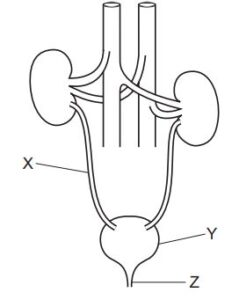
What are structures X, Y and Z?
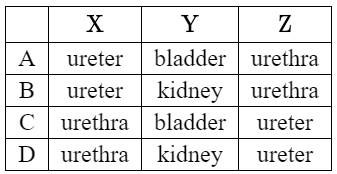
 Answer/Explanation
Answer/Explanation
A
In the context of the human excretory system and associated blood vessels, the structures X, Y and Z are: Ureter, Bladder and Urethra.
1. Ureter: Ureters are muscular tubes that connect the kidneys to the urinary bladder. Their primary function is to transport urine from the kidneys, where it is produced, to the urinary bladder, where it is stored until it’s ready to be eliminated from the body.
2. Bladder: The urinary bladder is a hollow, muscular organ located in the pelvic region. It serves as a temporary storage reservoir for urine. As urine accumulates in the bladder, it expands, and when it reaches a certain volume, nerve signals trigger the sensation of needing to urinate. The bladder can expand to accommodate varying amounts of urine before it is emptied through the urethra.
3. Urethra: The urethra is a tube that connects the urinary bladder to the external opening of the body. Its main function is to allow urine to exit the body during the process of urination. In males, the urethra also serves as a passage for semen during ejaculation.
These structures collectively make up the urinary system, which is responsible for regulating the concentration of waste products and excess water in the body by producing and eliminating urine.
Question
Which of these would increase the volume of urine produced by a human?
A being in a hot environment
B drinking large volumes of water
C suffering from diarrhoea
D running a long distance
 Answer/Explanation
Answer/Explanation
B drinking large volumes of water
Drinking large volumes of water (option B) would increase the volume of urine produced by a human. This is because the body needs to maintain a balance of fluids and electrolytes, and excess water intake can lead to increased urine output as the kidneys work to filter and excrete the excess water from the body.
The other options (A, C, and D) may have effects on the body’s fluid balance and urine production, but drinking large volumes of water is the most direct and consistent way to increase urine volume.
Question
Which substances are excreted by humans?

 Answer/Explanation
Answer/Explanation
A
Humans excrete several substances from their bodies, and among them are:
1. Urine: The primary waste product excreted by the kidneys. It contains excess water, electrolytes, and various waste products, including urea, creatinine, and uric acid.
2. Carbon Dioxide (CO2): This is a waste product of cellular respiration. During the process of converting glucose and oxygen into energy, carbon dioxide is produced as a byproduct. It is transported in the blood to the lungs, where it is then exhaled.
3. Urea: Urea is a nitrogenous waste product resulting from the breakdown of proteins in the liver. It is filtered out of the blood by the kidneys and excreted in urine. Urea helps to maintain the body’s nitrogen balance.
There are other waste products and substances that the human body excretes as well, including excess salts, minerals, water, and certain toxins. The excretory system, including the kidneys, liver, lungs, and skin, plays a crucial role in maintaining the body’s homeostasis by eliminating these waste products.
Question
A patient has dye injected into the blood supply to his kidneys. The dye appears in his excretory
system as shown.
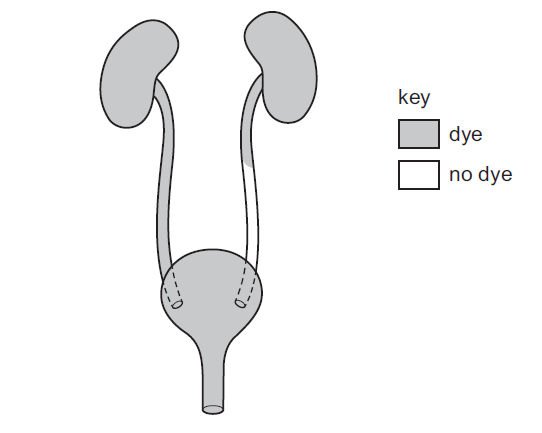
Which part is blocked?
A the kidney
B the ureter
C the bladder
D the urethra
 Answer/Explanation
Answer/Explanation
B
If the dye injected into the blood supply to the kidneys appears in the excretory system, but doesn’t seem to progress further, it indicates a blockage. The progression of the dye helps identify where the blockage might be located.
In this case, if the dye is injected into the blood supply to the kidneys but doesn’t reach the bladder, it suggests a blockage in the ureter. The ureter is the tube that carries urine from the kidneys to the bladder. So, the correct answer would be:
B the ureter
Question
Which set of conditions would make the percentage of water in urine decrease the most?
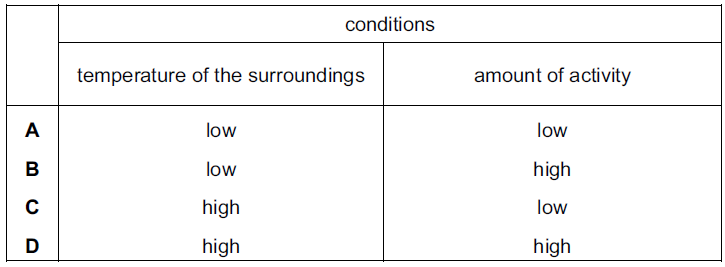
 Answer/Explanation
Answer/Explanation
D
The percentage of water in urine would decrease the most under the conditions of both high temperature of the surroundings and high amount of physical activity.
1. High Temperature of the Surroundings:
When the surroundings are hot, the body tends to increase its fluid loss through processes like sweating to regulate body temperature. The higher the ambient temperature, the more sweating occurs, leading to increased water loss from the body. As a result, the kidneys might concentrate urine more to conserve water, which would result in a decreased percentage of water in the urine.
2. High Amount of Activity:
Engaging in physical activities, especially rigorous ones, increases the body’s demand for energy and temperature regulation. During physical activity, the body’s metabolic rate increases, leading to higher energy expenditure and heat production. To dissipate this excess heat, the body increases sweating, which further contributes to water loss. As mentioned earlier, the kidneys might respond by concentrating urine to retain water, resulting in a lower percentage of water in the urine.
In summary, both high temperature of the surroundings and a high amount of physical activity can lead to increased water loss from the body through sweating. To compensate for this loss, the kidneys concentrate urine, causing the percentage of water in urine to decrease.
Question
The diagram shows the human urinary system.
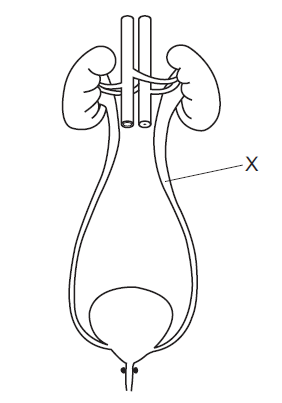
Which substance is not found in the liquid at X in a healthy person?
A glucose
B salt
C toxins
D urea
▶️Answer/Explanation
A
The substance that is not found in the liquid at point X in a healthy person is glucose. The human urinary system plays a crucial role in filtering waste products, excess ions, and other substances from the blood to form urine. In a healthy individual, glucose is reabsorbed by the kidneys, and it should not be present in significant amounts in the urine. If glucose is present in the urine, it can indicate a potential health issue, such as diabetes or impaired kidney function.
Question
What would be the effects of vasodilation and sweating on the body temperature and on the amount of moisture on the surface of the skin?
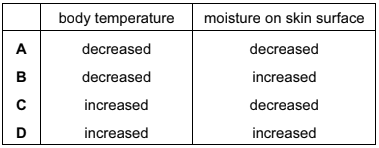
▶️Answer/Explanation
D
Vasodilation refers to the expansion or widening of blood vessels. When blood vessels dilate, they allow more blood to flow through, which can have several effects on the body’s temperature regulation:
Body Temperature: Vasodilation typically leads to an increase in blood flow near the skin’s surface. This allows excess heat to be transferred from the core of the body to the skin, where it can be released into the environment. As a result, vasodilation tends to have a cooling effect on the body, helping to regulate body temperature and prevent overheating.
Moisture on Skin Surface: Vasodilation can also lead to increased moisture on the skin surface due to increased blood flow. The skin may appear slightly flushed and feel warmer to the touch. This can cause a mild increase in perspiration, contributing to the cooling process as sweat evaporates from the skin.
Sweating, or perspiration, is the body’s natural way of cooling itself down through evaporative cooling. Sweat glands release a mixture of water and salts onto the skin’s surface, which then evaporates into the surrounding air. This process has the following effects:
Body Temperature: Sweating directly contributes to cooling the body. As sweat evaporates, it absorbs heat from the skin, thereby lowering the body’s temperature. Sweating is particularly effective in hot environments or during physical activity when the body needs to dissipate excess heat.
Moisture on Skin Surface: Sweating leads to an increased amount of moisture on the skin surface. The moisture from sweat can create a thin layer of liquid on the skin, aiding in the cooling process as it evaporates. This is why we often feel damp when we’re sweating.
In summary, both vasodilation and sweating play crucial roles in regulating body temperature and maintaining homeostasis. Vasodilation helps transport heat to the skin’s surface, while sweating aids in cooling through evaporative heat loss. Both processes lead to increased moisture on the skin surface, which contributes to cooling and maintaining a stable body temperature.
Question
Where is urea made?
A intestines
B kidney
C liver
D muscles
▶️Answer/Explanation
C
Urea is primarily produced in the liver. It is a waste product formed as a result of the breakdown of proteins and amino acids in the body. The liver processes these nitrogenous waste products and converts them into urea, which is then transported to the kidneys for excretion through urine. The correct answer is C – liver.
Question
Which organs remove excretory products from the blood?
A bladder and liver
B bladder and lungs
C kidneys and bladder
D lungs and kidneys
▶️Answer/Explanation
The correct answer is:
C. kidneys and bladder
The kidneys are responsible for filtering waste products and excess substances from the blood to form urine. The urine then travels from the kidneys to the bladder, where it is stored until it is eliminated from the body. The lungs primarily function in the respiratory system, not the excretory system, and the liver plays a role in detoxification and processing of various substances but is not a primary organ for removing excretory products from the blood.
Question
Which function does not occur in the kidneys?
A breakdown of alcohol
B removal of excess salts from the blood
C removal of excess water from the blood
D removal of urea from the blood
 Answer/Explanation
Answer/Explanation
A. Breakdown of alcohol
The correct answer is A. Breakdown of alcohol. The kidneys are primarily responsible for filtering blood, removing waste products, regulating electrolyte balance, and maintaining water balance. They do not play a significant role in breaking down alcohol. Alcohol is primarily metabolized in the liver through a process involving enzymes like alcohol dehydrogenase and acetaldehyde dehydrogenase.
Question
What is urea formed from?
A amino acids
B fatty acids
C glucose
D glycerol
▶️Answer/Explanation
A
Urea is primarily formed from amino acids. The correct answer is A. Amino acids are the building blocks of proteins, and during the process of protein metabolism, excess amino acids in the body are deaminated (having their amino groups removed) to form ammonia. Ammonia is toxic to the body in high concentrations, so the liver converts it into urea through a series of biochemical reactions known as the urea cycle.
Urea is water-soluble and less toxic than ammonia, making it a safer compound for the body to excrete. It is then transported to the kidneys through the bloodstream, filtered out of the blood by the kidneys, and eventually eliminated from the body through urine. This process is a crucial part of the body’s waste elimination system and helps maintain a proper balance of nitrogen compounds in the bloodstream.
Question
What shows the sequence of organs through which urea passes as it travels from where it is
produced to where it is removed from the blood?
A kidneys → heart → lungs → heart → liver
B kidneys → heart → liver → lungs → heart
C liver → heart → lungs → heart → kidneys
D liver → lungs → heart → kidneys → heart
▶️Answer/Explanation
C
The correct sequence of organs through which urea passes as it travels from where it is produced to where it is removed from the blood is option C: liver → heart → lungs → heart → kidneys.
Here’s the explanation for each step in the sequence:
1. Liver : Urea is primarily produced in the liver as a result of the breakdown of proteins and amino acids. This process occurs in the liver’s cells and is part of the body’s waste elimination process.
2. Heart : The heart pumps the blood throughout the body, including carrying the urea-rich blood away from the liver to the next destination.
3. Lungs : Urea is not directly removed in the lungs. However, the lungs play a role in gas exchange, allowing oxygen to enter the bloodstream and carbon dioxide to exit. Blood travels through the lungs to receive oxygen and release carbon dioxide before returning to the heart.
4. Heart: The heart pumps the oxygenated blood, now carrying urea, from the lungs to the next destination.
5. Kidneys: The kidneys are responsible for filtering waste products, including urea, from the blood. They play a crucial role in maintaining the body’s internal balance by excreting excess waste and regulating water and electrolyte levels. Urea is removed from the blood and excreted in the form of urine, which is then eliminated from the body.
So, the correct sequence is liver → heart → lungs → heart → kidneys, as outlined in option C.
Question
The graph shows the rates of sweat production and urine production at different environmental
temperatures.
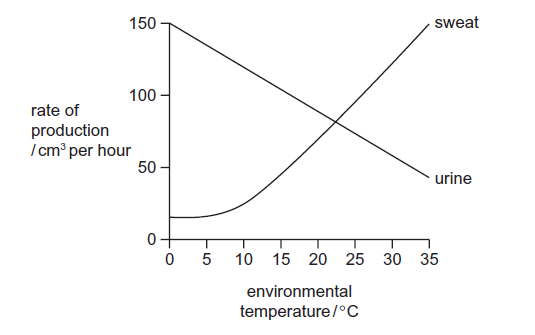
Which statement is correct?
A As the temperature increases, the rate of sweat production decreases.
B At 22 °C the rates of sweat and urine production are the same.
C Urine and sweat production are directly proportional to environmental temperature.
D When the urine production decreases, the sweat production decreases.
 Answer/Explanation
Answer/Explanation
B
The correct answer is B: “At 22 °C the rates of sweat and urine production are the same.”
At 22 °C, the graph indicates that the rates of sweat production and urine production intersect or cross each other. This intersection point suggests that at 22 °C, both sweat and urine production are occurring at approximately the same rate.
This suggests that the body’s physiological responses to maintaining temperature equilibrium involve both increased sweating and increased urine production when exposed to higher temperatures. The intersection point at 22 °C signifies the balance point where both mechanisms are equally active in response to the environment.
Question
What is the function of the anus?
A assimilation
B digestion
C egestion
D excretion
 Answer/Explanation
Answer/Explanation
The correct answer is C. Egestion.
The function of the anus is primarily to facilitate the process of egestion, which is the elimination of waste materials, such as undigested food, feces, and other substances, from the body. This is the final step in the digestive process, where the indigestible components of food that were not absorbed by the body are formed into feces and then expelled through the anus. The anus acts as a muscular opening through which these waste materials are eliminated from the digestive tract.
Question
The table shows a student’s water losses on a cool day.

On a hot day the student’s water intake was the same as on the cool day.
On the hot day, which water losses would increase and which would decrease?
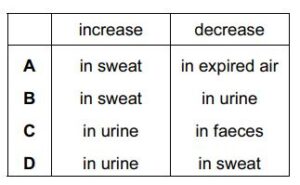
▶️Answer/Explanation
The answer is B; Increase in sweat, Decrease in urine.
Sweat: Sweat would increase on a hot day compared to a cool day. Sweating is the body’s natural cooling mechanism, and when it’s hotter, the body tends to sweat more to regulate its temperature.
Urine: Urine output could actually decrease on a hot day. When it’s hot, the body tends to conserve water to prevent dehydration. This can lead to a reduction in urine production as the body tries to retain more water.
So, in summary, on a hot day compared to a cool day:
– Sweat losses would likely increase due to higher temperatures and the body’s need to cool down.
– Urine losses would likely decrease as the body tries to conserve water to prevent dehydration.
Question
Which substance is lost from the body of a healthy person by the kidneys, but not by the lungs?
A carbon dioxide
B glucose
C urea
D water
 Answer/Explanation
Answer/Explanation
The substance that is lost from the body of a healthy person by the kidneys but not by the lungs is:
C. Urea
Urea is a waste product formed in the liver as a result of protein metabolism and is excreted primarily through the kidneys in the urine. The kidneys play a crucial role in filtering out urea from the blood and excreting it in the urine, whereas the lungs primarily expel carbon dioxide during the process of respiration. Glucose is reabsorbed by the kidneys if it’s not needed by the body, and water is also regulated by the kidneys but can be lost through the lungs via exhalation.
Question
Where is urea formed?
A kidneys
B liver
C muscles
D small intestine
 Answer/Explanation
Answer/Explanation
B. liver
Urea is primarily formed in the liver as part of the process of removing excess nitrogen from the body. It is a waste product resulting from the breakdown of proteins and amino acids. The liver converts ammonia, a highly toxic substance, into urea, which is then excreted by the kidneys through urine. The kidneys filter urea out of the blood and eliminate it from the body.
Question
A person is regularly connected to a machine that removes wastes, and excess salts and water,
from their blood.
Which organ’s function does the machine carry out?
A bladder
B kidney
C liver
D lung
▶️Answer/Explanation
The correct answer is B) kidney.
The function described, i.e., removing wastes, excess salts, and water from the blood, is a primary function of the kidneys in the human body. The machine mentioned in the scenario is likely a dialysis machine, which is used to perform the functions of the kidneys in individuals with kidney failure or impaired kidney function. The kidneys play a crucial role in maintaining the body’s internal environment by filtering the blood and regulating various substances in the blood, including waste products and electrolytes.
Question
Which organ regulates the amount of water in a mammal’s body?
A kidney
B liver
C lungs
D skin
 Answer/Explanation
Answer/Explanation
A
The organ that regulates the amount of water in a mammal’s body is the kidney. Kidneys are vital components of the mammalian urinary system and play a crucial role in maintaining the body’s water balance, electrolyte concentrations, and overall internal environment.
Kidneys filter waste products and excess substances, including water, from the bloodstream to form urine. They continuously monitor the composition of the blood and adjust the excretion of water and electrolytes accordingly. This regulation helps to maintain the body’s proper hydration levels, electrolyte concentrations (such as sodium, potassium, and chloride), and pH balance.
Through a complex process involving filtration, reabsorption, and secretion, the kidneys help control the volume and composition of urine. If the body is dehydrated, the kidneys conserve water by reducing the volume of urine produced and increasing the reabsorption of water back into the bloodstream. On the other hand, if the body has excess water, the kidneys excrete more water in the urine to maintain the proper balance.
Question
In which structure does storage and assimilation occur?
A liver
B mouth
C pancreas
D rectum
▶️Answer/Explanation
A
Storage and assimilation of nutrients primarily occur in the liver. The liver plays a crucial role in processing and storing nutrients, as well as regulating their release into the bloodstream for energy production and other bodily functions. It’s important for functions like glycogen storage, detoxification, and the synthesis of various proteins and biochemicals. The other structures mentioned (mouth, pancreas, and rectum) play important roles in digestion and nutrient processing as well, but they are not primarily responsible for storage and assimilation.
Question
The diagram shows the skin.
Which labelled structure releases sweat?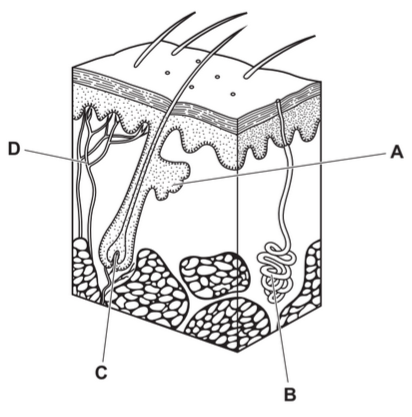
▶️Answer/Explanation
B
Sweat is released by structures called sweat glands (B), which are found in the skin. These glands are responsible for producing sweat, which is then released onto the skin’s surface through pores. Sweat glands play a crucial role in regulating body temperature by cooling the body through the process of evaporation. There are two main types of sweat glands: eccrine glands and apocrine glands. Eccrine glands are the most common type and are distributed throughout the body, while apocrine glands are found primarily in areas with dense hair follicles, such as the armpits and groin.
Question
The diagram shows the excretory system.
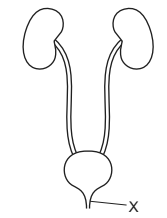
What is structure X?
A bladder
B kidney
C ureter
D urethra
▶️Answer/Explanation
D
The structure X is the Urethra. The urethra is a tube-like structure that is a part of the excretory system and plays a crucial role in the elimination of urine from the body. It serves as the final pathway through which urine is expelled from the urinary bladder and out of the body.
In males, the urethra has two main functions: it carries urine from the bladder to the outside of the body, and it also serves as a conduit for the passage of semen during ejaculation, as it is connected to the reproductive system. In females, the urethra is shorter and is primarily involved in the passage of urine.
The length and structure of the urethra can differ between males and females, but its basic function remains the same – to allow for the elimination of waste products (in the form of urine) from the body.
Question
Where is urea made?
A bladder
B kidney
C liver
D urethra
 Answer/Explanation
Answer/Explanation
C. liver
Urea is primarily produced in the liver through a biochemical process known as the urea cycle. It is a waste product formed as a result of the breakdown of amino acids, which are the building blocks of proteins. Urea is then transported to the kidneys for excretion in urine. The kidneys filter urea out of the blood and eliminate it from the body through the urine.
Question
What will be the effect of strenuous exercise on the volume of water lost through the skin and the
kidneys?
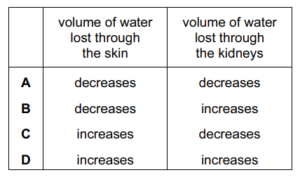
 Answer/Explanation
Answer/Explanation
C
During strenuous exercise, the body temperature tends to rise due to increased metabolic activity and heat generation. To regulate this temperature, the body initiates a cooling mechanism, primarily through sweating. Sweating increases the volume of water lost through the skin, as the sweat glands release fluids to the skin surface, where it evaporates and dissipates heat. So, the correct statement would be:
Volume of water lost through skin: Increases.
Strenuous exercise can lead to an increase in body temperature due to increased metabolic activity and muscle contractions. To cool down the body, sweat production increases, which results in water being released through the skin in the form of sweat. This can lead to an increase in the volume of water lost through the skin during exercise. So, your initial statement that the volume of water lost through the skin increases is accurate.
Volume of water lost through the kidneys: Decreases.
Strenuous exercise can also affect the volume of water excreted by the kidneys, primarily through urine. While exercise itself does not directly cause a decrease in kidney function, it can lead to an increase in fluid loss through sweating, which might lead to a decrease in urine production during and immediately after exercise. The body’s response to sweating and fluid loss can involve conserving water to maintain hydration levels.
Question
Which row describes the functions of the bladder, kidneys and liver?
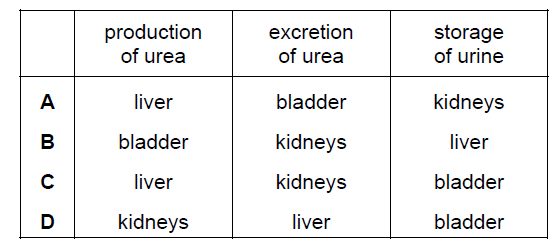
▶️Answer/Explanation
C
Bladder: The bladder is responsible for storing urine produced by the kidneys until it is ready to be eliminated from the body. It expands to accommodate increasing amounts of urine and contracts to expel the urine during urination.
Kidneys: The kidneys are vital organs that filter waste products, excess fluids, and electrolytes from the blood to form urine. They also play a key role in regulating blood pressure, maintaining electrolyte balance, and producing hormones that influence red blood cell production and bone health.
Liver: The liver has multiple functions, including the production of urea from ammonia, which is a waste product of protein metabolism. Urea is then transported to the kidneys for elimination in urine. Additionally, the liver is involved in detoxifying chemicals, metabolizing nutrients, storing glycogen for energy, and producing important proteins for blood clotting and immune system support.
Question
Where does egestion take place?
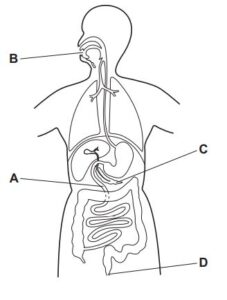
▶️Answer/Explanation
D
Egestion is the process of eliminating undigested waste materials, such as indigestible food particles and other substances, from the body. In most organisms, egestion takes place in the lower part of the digestive system, specifically in the large intestine or colon (Part D).
After the process of digestion and absorption in the small intestine, the remaining indigestible materials, water, and some minerals move into the large intestine. Here, the colon’s main function is to absorb water and electrolytes, which helps in the formation of feces. The undigested and unabsorbed materials continue to move through the colon, and eventually, the indigestible waste is compacted and formed into feces.
Once the feces have been formed, they are stored in the rectum until they are ready to be eliminated from the body through the process of defecation, which is the final step of egestion. The feces are expelled from the body through the anus.
It’s important to note that the specifics of egestion may vary between different organisms, so the process could be slightly different depending on the type of organism you’re referring to.
Question
The graph shows the rates of sweat production and urine production at different environmental
temperatures.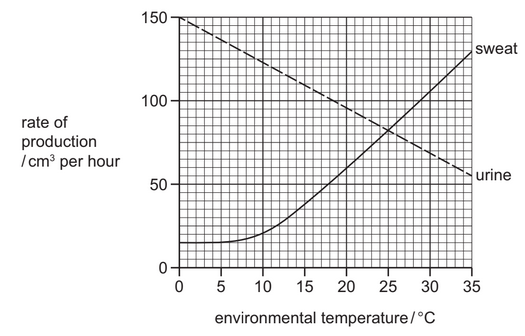
Which statement is correct?
A As the temperature increases, the rates of sweat and urine production increase.
B As the temperature increases, the rate of urine production increases.
C At 250 C the rates of sweat and urine production are the same.
D Urine and sweat production are directly proportional to environmental temperature.
▶️Answer/Explanation
C
The correct answer is C : At 250 C the rates of sweat and urine production are the same.
At 250 C, the graph indicates that the rates of sweat production and urine production intersect or cross each other. This intersection point suggests that at 25 °C, both sweat and urine production are occurring at approximately the same rate.
This suggests that the body’s physiological responses to maintaining temperature equilibrium involve both increased sweating and increased urine production when exposed to higher temperatures. The intersection point at 25 °C signifies the balance point where both mechanisms are equally active in response to the environment.
Question
Which mechanism for maintaining body temperature involves the action of muscles?
A detection of temperature
B insulation with fatty tissue
C shivering
D sweating
▶️Answer/Explanation
C
The mechanism for maintaining body temperature that involves the action of muscles is:
C. Shivering
Shivering is the involuntary contraction and relaxation of muscles, particularly skeletal muscles, in response to cold temperatures. This action generates heat, helping to raise the body’s temperature and maintain it within a functional range. This is one of the body’s physiological responses to cold environments in order to prevent hypothermia.
Question
Which statement about urea is correct?
A Urea is formed from excess amino acids in the kidneys and excreted by the liver.
B Urea is formed from excess glucose in the liver and egested by the kidneys.
C Urea is formed from excess glucose in the kidneys and egested by the liver.
D Urea is formed from excess amino acids in the liver and excreted by the kidneys.
▶️Answer/Explanation
D
The correct statement about urea is:
D Urea is formed from excess amino acids in the liver and excreted by the kidneys.
Urea is a waste product that results from the breakdown of excess amino acids in the liver through a process called deamination. The liver converts the ammonia produced during deamination into urea, which is then transported through the bloodstream to the kidneys for excretion in the urine. This process helps to regulate the body’s nitrogen balance and eliminate excess nitrogen in the form of urea.
Question
The diagram shows part of the alimentary canal.
Which structure produces lipase?
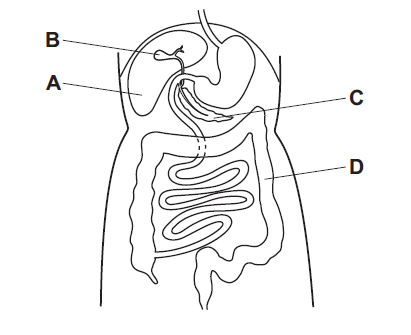
▶️Answer/Explanation
C
In the alimentary canal, specifically in the digestive system, the pancreas is the primary structure responsible for producing lipase. Lipase is an enzyme that plays a crucial role in the digestion and breakdown of dietary fats (lipids) into smaller molecules, such as fatty acids and glycerol, which can be absorbed and utilized by the body.
The pancreas releases digestive enzymes, including lipase, into the small intestine to aid in the digestion of various nutrients, including fats. This process helps facilitate the absorption of nutrients from the digested food into the bloodstream.
Question
What is the most important function of sweating?
A to remove excess heat from the body
B to remove excess salts from the body
C to remove excess urea from the body
D to remove excess water from the body
 Answer/Explanation
Answer/Explanation
Ans:
A to remove excess heat from the body
Sweating is primarily a mechanism for regulating body temperature. When the body gets too hot, sweat glands produce sweat, which evaporates from the skin surface and helps to cool down the body. This process is crucial for maintaining a stable internal temperature and preventing overheating. While sweating does contain some salts and trace amounts of urea, its primary function is to dissipate heat.
Question
The table shows information about urea.
Which row is correct?
| substance that urea is made from | organ that makes urea | organ that excretes urea | |
A B C D | amino acids amino acids fatty acids fatty acids | kidney liver kidney liver | bladder kidney bladder kidney |
▶️Answer/Explanation
B
Urea is a compound that plays a crucial role in the body’s nitrogen metabolism and waste elimination processes. Here’s some information about urea:
1. Substance that Urea is Made From: Amino Acid
Urea is a chemical compound with the molecular formula CO(NH₂)₂. It is primarily synthesized in the liver from ammonia and carbon dioxide. Ammonia is generated as a byproduct of amino acid metabolism, particularly the breakdown of proteins and other nitrogen-containing compounds in the body. The liver combines ammonia and carbon dioxide to form urea through a process called the urea cycle, also known as the ornithine cycle.
2. Organ that Makes Urea: Liver
As mentioned earlier, the liver is the primary organ responsible for producing urea. It plays a central role in the urea cycle, which is a series of biochemical reactions that occur in the liver’s hepatocytes (liver cells). The cycle involves several enzymes and intermediate compounds to convert ammonia and carbon dioxide into urea, which is then transported to the bloodstream for eventual excretion.
3. Organ that Excretes Urea: Kidneys
Urea is considered a waste product resulting from the body’s metabolism of proteins and amino acids. It needs to be eliminated from the body to prevent the accumulation of toxic ammonia. The kidneys, part of the body’s urinary system, are responsible for excreting urea. Urea is filtered out of the blood by the kidneys and then concentrated in the urine. The urea-rich urine is eventually expelled from the body during the process of urination.
In summary, urea is a compound derived from the metabolism of amino acids, synthesized primarily in the liver, and excreted by the kidneys as a waste product. It is an essential part of the body’s nitrogen disposal system, helping to maintain proper nitrogen balance and prevent the buildup of toxic ammonia.
